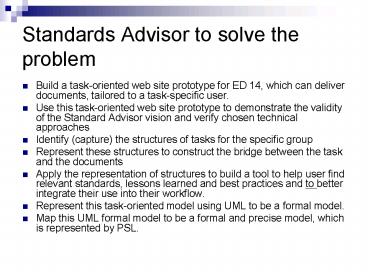Standards Advisor to solve the problem
1 / 15
Title:
Standards Advisor to solve the problem
Description:
Build a task-oriented web site prototype for ED 14, which can deliver ... MILOS: A Model of Interleaved Planning, Scheduling, and Enactment. H.Holz, F.Maurer. ... –
Number of Views:52
Avg rating:3.0/5.0
Title: Standards Advisor to solve the problem
1
Standards Advisor to solve the problem
- Build a task-oriented web site prototype for ED
14, which can deliver documents, tailored to a
task-specific user. - Use this task-oriented web site prototype to
demonstrate the validity of the Standard Advisor
vision and verify chosen technical approaches - Identify (capture) the structures of tasks for
the specific group - Represent these structures to construct the
bridge between the task and the documents - Apply the representation of structures to build a
tool to help user find relevant standards,
lessons learned and best practices and to better
integrate their use into their workflow. - Represent this task-oriented model using UML to
be a formal model. - Map this UML formal model to be a formal and
precise model, which is represented by PSL.
2
Task-oriented web site Prototype
- To provide NASA ED14 Flight Software Group with
activity-specific information which includes
related Standards, lessons learned and other
guidance.
3
How to provide information
- http//cs.ua.edu/graduate/hma/Advisor/prototype.ht
m - Use cascading menu to represent a dynamic
navigation to let user browser and make choice
easily. once user decide a specific activity,
he/she can view the task-oriented guidance. - After the activity done, user can create the
related task-oriented lessons for that activity.
4
Features of task-oriented web site prototype
- 1.The Standards Advisor task-oriented web site
is to provide NASA ED 14 Flight Software Group
with an access to the group-specific (for ED 14)
and activity-specific information including the
specific documents (standards and guidelines) the
group uses for their specific activities and
other additional information (such as lessons
learned). - 2.This task-oriented web site also enables
external web sites and applications to link to
relevant standards and associated documents. - It allows users to link to external web sites.
- It also allows other web pages link to
the task-oriented web site. - 3.This task-oriented web site can link to
the search interface of NASA technique.
5
Knowledge Captured in the prototype
- The structures captured during the prototype
building - Activity hierarchy structure
- The structure to use lessons and to develop new
lessons - The structure to provide a creation of link to
the relevant standards for lessons - The structure to link external information
- Link standards to application nets
- Link materials standards to its database
- Link electronic parts standards to supplier of
these parts - Other structures (missing structure will be
compensated by search engines)
6
Activity hierarchy structure
- Activity Description
- Sub Activities
- Products/Documents Used
- Products/Documents Created
- Guidance for Performing the activity
7
Guidance for Performing the activity
- Create Lessons for this activity
- View Lessons for this activity
- Search for Lessons, Standards, and other guidance
about this activity.
8
UML Modeling the task-oriented model
9
UML Modeling the task-oriented model (class
diagram)
10
Some Concepts and their explanation in
Task-Oriented Model of UML
11
Literature review
- A.Gabrel, R.Josefinna. Process Modeling in a
Software Engineering.2001 - H.Holz, A.Konnecker, F.Maurer Task-Specific
Knowledge Management in a Process-Centered SEE. - S.Goldmann,J.Munch,H.Holz. MILOS A Model of
Interleaved Planning, Scheduling, and Enactment. - H.Holz, F.Maurer. Process-Oriented Knowledge
Management for Learning Software Organization. - S.jablonski,S.Horn,M.Schlundt. Process Oriented
Knowledge Management. - L.Scott, L.Carvalho, R.Jeffery. A
Process-Centered Experience Repository for a
Small Software Organization. - F.Maurer, B.Dellen. An Internet Based Software
Process Management Environment. - P.Nour, H.Holz, F.Maurer. Ontology-based
Retrieval of Software Process Experiences.
12
Possible Next Steps
- Continue to represent all structures identified
from task-oriented web site prototype. - Organize exiting documents using the
representation of structures (harvest metadata)
such that deconstruct the document to be
components as the UML class diagram showing.
Realize these pieces of document in the
task-oriented web site and make the interaction
with developer smoothly. - The prototype for showing this interaction
can be viewed at the following - http//cs.ua.edu/graduate/hma/Advisor/docume
ntslistSample.htm
13
Possible Next Steps (continue)
- Add metadata to existing and new documents of new
tasks - Exploit the metadata (new search techniques,
agents etc.) - Provide tools to develop and maintain metadata.
- Develop a Task model for the domain knowledge
which is the bridge between the tasks and
documents
14
Possible Next Steps (continue)
- Map the UML model of this task-oriented model to
be a more precise model of PSL. - Map the UML model to be XML model.
- Realize the task model using specific
task-oriented web site prototype. - Summarize the ontology on this task-oriented
model.
15
Technologies
- UML Unified Modeling Language
- PSL Process Specification Language
- Semantic web tools
- -XML and XML Schema tools
- -Hierarchy of RDF query languages
- -RDF and RDF Schema
- Metadata technologies
- Software Agents































